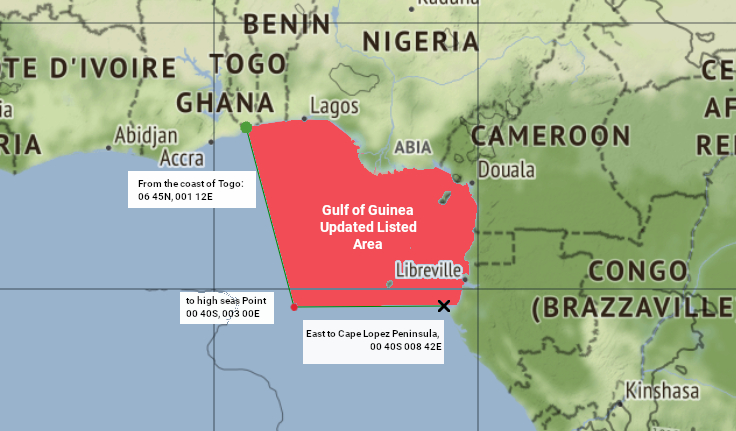The Joint War Committee (JWC), a group composed of representatives from Lloyd’s Market Association (LMA) and the International Underwriting Association (IUA), have issued an updated advisory regarding their Listed Area in the Gulf of Guinea. While previously the Listed Area included only coastal territory surrounding states in the Gulf, the Listed Area now extends south of Principe Island, and further west encompassing a large area of open ocean. (Insert Reference Image)

Vessel’s transiting these Listed Areas face an increase risk of piracy and thus vessel owners are required to notify their insurance underwriter of voyages which will pass through these areas. The other Listed Areas, in the Indian Ocean and the coastal waters around Venezuela, remain unchanged from the May 2019 JWC Advisory.
Pirate attacks have increased in 2020 over their 2019 levels. In the first 6 months of this year, the IMB (International Maritime Bureau) recorded 98 attacks , a 25% increase over 2019 levels with many of these attacks occurring within the Gulf of Guinea. On September 09th, 2 Russian crew were kidnapped from the Water Phoenix, 31nm off the coast of Nigeria while en-route to Lagos, the latest vessel to be targeted in the area. So far in 2020 there have been 49 recorded kidnappings in the West African region alone, putting 2020 on track to far exceed the number of kidnappings reported in 2019.

While typically pirate attacks occur close to shore, this year some vessels have been attacked further out to sea with some incidents occurring hundreds of kilometers away from the shore. This increased range is enabled by pirate “Motherships” which carry fuel and supplies for the fast speedboats used in attacks. The increased range and frequency of pirate attacks in the Gulf of Guinea is likely the reason for the JWC’s expansion of the West African Listed Area as it is now apparent that ships are vulnerable even while sailing in open ocean.
Some have speculated that the uptick in pirate activity is a result of the ongoing Coronavirus pandemic, which has lead to economic hardship for many in the region and has shifted the focus of security forces elsewhere. The data on piracy for 2020 shows that 65% of kidnappings in the Gulf of Guinea occurred between May and July, roughly concurrent with when most of the world imposed economic lockdowns.
While the Covid-19 pandemic may be partially responsible for 2020’s increase , there has been a general trend within the Gulf of Guinea towards increased pirate activity. While piracy has been generally on the rise in the GOG, there has been a decline in activity occurring in the Gulf of Aden and off the coast of Somalia. There are several potential causes for this including naval operations by the US and NATO as well as an increase in the number of commercial vessels employing armed guards when traveling through the area.
Unfortunately, efforts to combat piracy in the GOG have been stymied by barriers to international cooperating and the states bordering the Gulf of Guinea currently do not permit armed guards aboard commercial ships. Given the current state of affairs it is likely that piracy will continue to be a problem in this region potentially for years to come. Thankfully owners and charterers still have some tools at their disposal to help mitigate risk and ensure the safety of seafarers. True North Marine’s operations staff are well acquainted with global HRA and Listed Area limits and have been safely routing vessel around these zones since our inception. Skirting these zones and minimizing transit times through any potentially dangerous areas is one way to help ensure that your vessel and crew arrive at their destination safely and without delay.
If you have any questions about how TNM can help keep your vessel’s safe and secure through route planning or weather routing, we’d love to hear from you!




